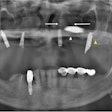
Aribex, which has pioneered the handheld digital x-ray market with its Nomad device, is suing a group of competitors over alleged patent infringement.
The lawsuit names DigiMed, Sigma Biomedics (doing business as Sigma Digital X-ray), and Dentalaire Products as defendants. Sigma and Dentalaire distribute the Bio-Ray Prox, a portable x-ray device manufactured in Korea by DigiMed.
— D. Clark Turner, Ph.D., president and
CEO of Aribex
The complaint, filed in the U.S. District Court in Salt Lake City, comes after a number of attempts by Aribex to resolve concerns over the alleged infringement of Aribex patents by several different manufacturers and importers, the company stated in a press release.
The complaint alleges that Aribex intellectual property (IP) rights -- namely, U.S. Patent No. 7,496,178, which protects the central concept of having all components of the x-ray system in the same enclosure, and U.S. Patent No. 7,224,769, for the digital x-ray camera itself -- are being knowingly and unfairly violated.
"Aribex has spent considerable time and money to establish the value proposition of handheld x-ray," said D. Clark Turner, Ph.D., president and CEO of Aribex and inventor of the Nomad. "We consider our IP to be one of our core assets and plan to aggressively defend and enforce our IP rights. This is the first visible step in that process."
Kim Antol, president of Sigma Digital X-ray, declined to comment on the lawsuit or provide details about the Bio-Ray Prox, saying the company is still reviewing Aribex's complaint. Dentalaire had not responded to a request for comment as of press time.
A number of companies have introduced handheld digital x-ray products to the U.S. market this year. In addition to Aribex, DigiMed, and Sigma, following FDA clearance earlier this year Video Dental Concepts launched the Diagnostix X-Ray2go (also known as the EXARO DXR-1), which is manufactured in Korea by EXARO -- a joint venture between DigiMed and OSSTEM, another Korean company.
But it is unclear where these products are with regard to state regulation. Aribex has spent the last three years going state by state talking to dental boards to gain the necessary clearances to allow dentists to use the Nomad. So far, some 40 states have given their OK, according to the company.
Aribex also has concerns about the radiation protection incorporated into the competing devices. The Nomad uses internal shielding to block radiation leakage and a backscatter shield to protect the operator from x-rays scattered from the patient. According to the Sigma Digital X-Ray site, the Bio-Ray Prox features "a high-frequency DC [direct current] tube for less patient exposure and better image quality" and "unique internal shielding to protect the operator from radiation."
According to the Video Dental Concepts Web site, the X-ray2go features "a high-frequency inverter to generate a stable x-ray output with DC high voltage. This effective DC unit enables patient and operator to be exposed to the least amount of radiation."
"Traditionally, x-rays were hung on the wall, since the technology did not exist to do it any other way," Turner said. "Technological enhancements have made it possible to make the x-ray smaller and lighter and safe enough to hold in your hand. Aribex was the first to patent and market a product with those technological enhancements, and we have been defining the market for handheld intraoral x-ray ever since."
Copyright © 2009 DrBicuspid.com



















